Road traffic is one of the main sources of energy consumption and environmental pollution because vehicles on the road are dependent on oil-derived fuels in conventional gasoline vehicles(GVs).These fuels accelerate energy consumption and generate large amounts of tailpipe emissions of pollutants, such as NOx and VOCs[1].Instead of gasoline-powered automobiles, automotive manufacturers and research institutes are striving to look for new types of vehicles, such as electric vehicles(EVs), to cope with these problems[2].Compared with conventional GVs, EVs, especially battery EVs(BEVs), can significantly reduce greenhouse emissions and mitigate excessive consumption of fossil fuels[3-5].BEVs are also known to rely entirely on electricity.The electricity consumption of BEVs is generally proportional to the driving distance, and the driving range of BEVs is limited by the battery capacity.BEVs cannot be driven any farther longer once their driving distance is larger than their driving distance limitation because the battery storage of BEVs has been exhausted, and public electricity-charging stations of BEVs are insufficient[6].In this case, the fear of running out of batteries while traveling has led to the so-called range anxiety issue.Battery storage and charging technologies have experienced significant progress, and the number of new public charging stations is also increasing.However, range anxiety remains to be one of the main barriers hindering the widespread acceptance and adoption of BEVs[7].A general belief is that range anxiety might not be completely eliminated in the near future[8-9].Range anxiety will continue to affect the travel choices of BEV drivers.Therefore, the range anxiety issue must be properly addressed in the process of traffic assignment modeling, particularly for regions where BEVs are expected to grow rapidly.
Studies on incorporating range anxiety issues into the traffic assignment model have been conducted in the literature.Jiang et al.[8] proposed a user equilibrium(UE)model with a distance limit, which is described by setting the path flow to zero when the path length exceeds the driving range limit.Jiang et al.[10] further extended the model to investigate the coexistence of GVs and BEVs, as well as their combined choices of destination, route, and parking, which are affected by the distance limit.Jiang et al.[6] formulated a network equilibrium problem regarding the selection of modes and routes based on travelers who own GVs and BEVs and analyzed the effects of operation costs and distance limits on vehicle and route choices of these travelers.However, these studies did not consider the behaviors of BEV users at the charging stations.To this end, He et al.[9] and Xie et al.[11] considered the time required for recharging and incorporated the relay requirement of EVs in their long-haul trips, which is typically beyond the distance limit.Xu et al.[12] developed a mathematical model for the UE problems by considering battery swapping stations and road grade constraints.On this basis, Liu et al.[13] presented the UE conditions to describe the route choice behaviors of BEV drivers considering flow-dependent electricity consumption.Tran et al.[14] developed a bi-level optimization framework to determine the optimal location of public fast-charging stations.Notably, the abovementioned traffic assignment models are mainly in the UE context.In this regard, Jing et al.[15] formulated a general MNL-based SUE model with a distance limit to extend the UE model.Riemann et al.[16] proposed a mixed-integer nonlinear model to determine the optimal location of wireless charging facilities for EVs.The model considers the interaction between the facility location and the traffic flow pattern captured by the MNL-based SUE model.Yang et al.[17] proposed a stochastic UE model for EVs by considering travel time, energy consumption, and charging service time.Huan et al.[18] proposed a dynamic traffic flow assignment model considering the en-route fast-charging behavior of users.Gao et al.[19] proposed a bilevel model to investigate the interaction between traffic flow distribution and the location of charging stations in a hybrid network of EVs and traditional GVs.
Traffic assignment is a fundamental technique for transportation management.The stochastic user equilibrium(SUE)-based traffic assignment model has been widely adopted to deal with various perceptions of travelers.Most SUE models in the literature use the multinomial logit(MNL)route choice model.However, the assignment results are generally inadequate or impossible to account for similarities between different paths, that is, the overlapping path issue, due to the well-known IIA property of the MNL model[20], Daganzo et al.[21] proposed the multinomial probit(MNP)model, which has an advantage that the similarity between alternatives can be considered.However, the MNP model is computationally unattractive because its probability function is not a closed form.In addition, other discrete choice models that can capture similarity among various routes have been extensively studied.The first category is modifications to MNL, such as C-logit[22-23] and path-size logit[24-25], which capture similarities through additional terms in the systematic utilities of the various routes.The second category is the generalized extreme value theory, such as the paired combinatorial logit(PCL)model[26-27], cross-nested logit(CNL)model[28-30], and generalized nested logit(GNL)model[31],which capture similarities by allowing additional general correlation structures.Notably, the PCL and CNL models are special cases of the GNL model.Furthermore, some researchers have adopted the GNL-based route choice model in the SUE modeling process.Bekhor et al.[31] proposed a mathematical formulation of the SUE model with GNL by adding an entropy term to the objective function.Li et al.[32]extended the model in Ref.[31]to formulate a GNL-based multiclass multicriteria SUE model.From a different perspective, Koppelman et al.[33] proposed a heterogeneous GNL model that allows for heterogeneity in error variance and covariance structure to represent the complex behavioral processes involved in choice decision-making.
The range anxiety and overlapping path issues are essential or critical for traffic assignment with motor vehicles involving BEVs.Numerous studies were proposed to address the overlapping path and the range anxiety issues in traffic assignment.However, none of these models addressed the two issues together.Thus, this paper aims to develop and evaluate a framework addressing the two issues simultaneously.Hence, a generalized nested logit-based SUE(GNL-SUE)model with multiple user classes(i.e., GV and BEV users)and distance limits was designed.In addition, the analytical solution was proposed to solve this modified GNL-SUE model.
1 Generalized Nested Logit Model Review
The GNL model is described as a two-level nesting structure.Specifically, the upper layer comprises all links(nests)in the network, and the lower layer includes all paths(alternatives)in the path set.Assuming that this structure is adopted, the probability of choosing path k for user class i between O-D pair w is then given by

∀w,i,k
(1)
where ![]() is the travel cost of user class i on path k between OD pair w; θi is the dispersion parameter that characterizes the familiarity of user class i with the road network;
is the travel cost of user class i on path k between OD pair w; θi is the dispersion parameter that characterizes the familiarity of user class i with the road network; ![]() is the inclusion coefficient, which indicates that the portion of alternative k is assigned to nest m between O-D pair w.Prashker et al.[34] indicated that
is the inclusion coefficient, which indicates that the portion of alternative k is assigned to nest m between O-D pair w.Prashker et al.[34] indicated that  where Km is the set of all alternatives included in nest m.The nesting coefficient
where Km is the set of all alternatives included in nest m.The nesting coefficient ![]() indicates the absence of a common link between the two paths, in which case the GNL model collapses to the MNL model.
indicates the absence of a common link between the two paths, in which case the GNL model collapses to the MNL model.
Eq.(1)can be further decomposed into marginal and conditional probabilities, and the expression may be rewritten as
(2)
The marginal probability can be described as

∀w,i,m
(3)
and the conditional probability may be given by the following equation:

(4)
2 Proposed Mathematical Model for the Modified GNL-SUE Model
2.1 Modified GNL-SUE model
The conventional GNL-SUE model is modified in this paper by incorporating the constraints of multiple user classes of GVs and BEVs and the distance limit of BEVs to handle the range anxiety and overlapping path issues jointly.To simplify the complexity of the modified GNL-SUE model, a series of assumptions are proposed:
1)The travel demand population includes only GV and BEV users.
2)The total travel demand for each type of vehicle at each origin is predetermined.
3)GV and BEV users have the same travel time on the same path.
4)Without loss of generality, all EVs are fully charged at their origins.
2.2 Proposed mathematical model
The objective function of the modified GNL-SUE model with multiple user classes and distance limits can be decomposed into UE mathematical formulation and two entropy terms.Specifically, the first term(Z1)characterizes the deterministic UE formulation.The second term(Z2)is similar to the MNL-SUE model in the formulation of Fisk[35] but is modified to contain inclusion and nesting coefficients.The third term(Z3)shows that the flow ![]() is aggregated by all paths.The modified GNL-SUE model with multiple user classes and distance limits can be expressed as the mathematical model shown below based on the above analyses:
is aggregated by all paths.The modified GNL-SUE model with multiple user classes and distance limits can be expressed as the mathematical model shown below based on the above analyses:
min Z=Z1+Z2+Z3
where
(5)
s.t.
(6)
(7)
(8)
(9)
(10)
where ![]() is the total demand of user class i between O-D pair w; xa is the flow on link a; xai is the flow on link a for user class i; Di is the distance limit of user class i;
is the total demand of user class i between O-D pair w; xa is the flow on link a; xai is the flow on link a for user class i; Di is the distance limit of user class i; ![]() is the length of path k between O-D pair w.
is the length of path k between O-D pair w.
Eq.(6)represents the flow conservation constraints; that is, the flow on all paths connecting each O-D pair must be equal to the O-D trip demand for user class i.Eq.(7)indicates that if the path length is less than or equal to the distance limit for a given user class i, then the flow on that path is positive; otherwise, the path flow should be equal to zero.Eq.(8)denotes the incidence relationship between link-path flows.Eq.(9)is a summation of the link flows of the user class i, while Eq.(10)is the flow of nonnegativity constraint.
2.3 Equivalence and uniqueness conditions
Proposition 1 The proposed mathematical model is equivalent to the modified GNL-SUE model with multiple user classes and distance limits.
Proof Any flow pattern obtained by solving Eqs.(5)to(10)is generally acknowledged to satisfy the SUE condition.The Lagrangian of the proposed mathematical model can be formulated as
(11)
where ![]() are dual variables associated with the flow conservation constraint.
are dual variables associated with the flow conservation constraint.
The first-order conditions of the proposed mathematical model are equivalent to the first-order conditions of Lagrangian.Therefore, the following conditions must hold at the stationary point of the Lagrangian considering the path-flow variable, that is,
(12)
The partial derivatives of L(f,μ,λ)considering the path-flow variable is then given by
(13)
L(f,μ,λ)must be minimized considering nonnegative path flows.Thus, the expression can be rewritten as
(14)
Assume that the composite path cost for user class i includes the path travel time and ![]() is the path out-of-range cost incurred when the path length exceeds the distance limit of the user class i.The equation of path cost is defined as
is the path out-of-range cost incurred when the path length exceeds the distance limit of the user class i.The equation of path cost is defined as
(15)
Submitting Eq.(15)into Eq.(14)and multiplying both sides by θi, the following is obtained:
(16)
Dividing both sides by ![]() and taking the logarithm of exp as the base, Eq.(16)can be rewritten as
and taking the logarithm of exp as the base, Eq.(16)can be rewritten as
(17)
Summing the above expression by path k, the following is obtained:
(18)
Elevating both sides to ![]()
![]()
![]()
(19)
Summing Eq.(19)by link(nest)m,
![]()
![]()
(20)
Dividing Eq.(19)by Eq.(20), the marginal probability that nest m will be chosen is obtained as shown below.


(21)
Dividing Eq.(18)by Eq.(19),

(22)
Thus, the conditional probability of path k will be chosen in nest m.
Therefore,Eqs.(21)and(22)correspond to Eqs.(3)and(4), respectively.Notably, the path costs in Eqs.(1),(3), and(4)are denoted by ![]() because the path out-of-range cost when the path length exceeds the distance limit is included.Thus, the mathematical formulation presented in Eq.(5)corresponds to the GNL-SUE model with a distance limit.
because the path out-of-range cost when the path length exceeds the distance limit is included.Thus, the mathematical formulation presented in Eq.(5)corresponds to the GNL-SUE model with a distance limit.
Proposition 2 The proposed mathematical model has a unique solution.
Proof Demonstrating that the Hessian matrix of the objective function of the proposed mathematical model is positive definite is sufficient to prove the uniqueness of the solution.The feasible region of Z1 is the same as Fisk’s formulation; thus, it is convex.The second derivative of Z2 and Z3 can be calculated as follows:

(23)

(24)
Obviously, the Hessian matrices of Z2 and Z3 are positive definite and positive semidefinite, respectively, which ensures the convexity of the objective function.Thus, the solution to the proposed mathematical model is unique considering the path-flow variable ![]()
2.4 MSA-based solution to the proposed mathematical model
The method of successive average(MSA)is adopted to solve the proposed mathematical model.The application steps of the MSA algorithm to solve the proposed mathematical model are presented below.
Step 1 Parameter settings.Determine a feasible path set.Meanwhile, set the distance limit D and the convergence tolerance ε.
Step 2 Initialization.Calculate inclusion coefficients α and nesting coefficients μ.Find an initial path flow f(1).Set iteration counter n=1.
Step 3 Update.Calculate the link flow x(n) based on the current path flow f(n).Update the link travel time c(x(n))and path travel time T(n).
Step 4 Direction finding.Perform a stochastic network loading based on the current set of path travel time T(n), yielding an auxiliary solution Y(n).
Step 5 Move.Set f(n+1)=f(n)+(1/n)(Y(n)-f(n)).Notably, the step size is the reciprocal of the number of iterations.
Step 6 Convergence test.If ‖f(n+1)-f(n)‖/‖f(n)‖≤ε, then stop; else, set n=n+1 and go to Step 3.
3 Numerical Examples
Two road networks are selected in this section for testing the purpose of this paper.Specifically, a small network containing overlapping and nonoverlapping paths is first selected to show the performance of the proposed mathematical model handling the overlapping path issue.The result indicates that the distance limit has an important impact on the path and link flows at equilibrium.The well-known Nguyen-Dupuis network is selected to demonstrate the performance of the proposed mathematical model handling the range anxiety issue by analyzing the effect of changes in distance limits on the path flows of GV and BEV.
3.1 Small network: Performance for overlapping path issue
The small network comprises 1 O-D pair, 5 links, and 3 paths, as shown in Fig.1.The total demand is equal to 1000.In addition, the BPR function is used to calculate link travel time, in which its coefficients are set to α=0.15 and β=4.The distance limit of BEVs is set to 10 herein, and the distance limit of GVs is unlimited.The market share for GVs and BEVs is defined as 0.5 and 0.5,respectively.The dispersion parameters of GV and BEV users are respectively set to 0.3 and 0.5.The iteration accuracy of the MSA-based solution algorithm is defined as ε=0.000 1.The free-flow travel time and capacity for each link on this small network are shown in Tab.1, and the path composition and length are exhibited in Tab.2.The values in Tabs.1 and 2 are adopted from Li et al[32].
Tab.1 Link characteristics of the small network

No.Linkt0ac-a11-2560021-3650032-3760042-4850053-43700
Tab.2 Path composition and path length

O-DPathNode sequencePath length11-2-4131-421-2-3-41531-3-49
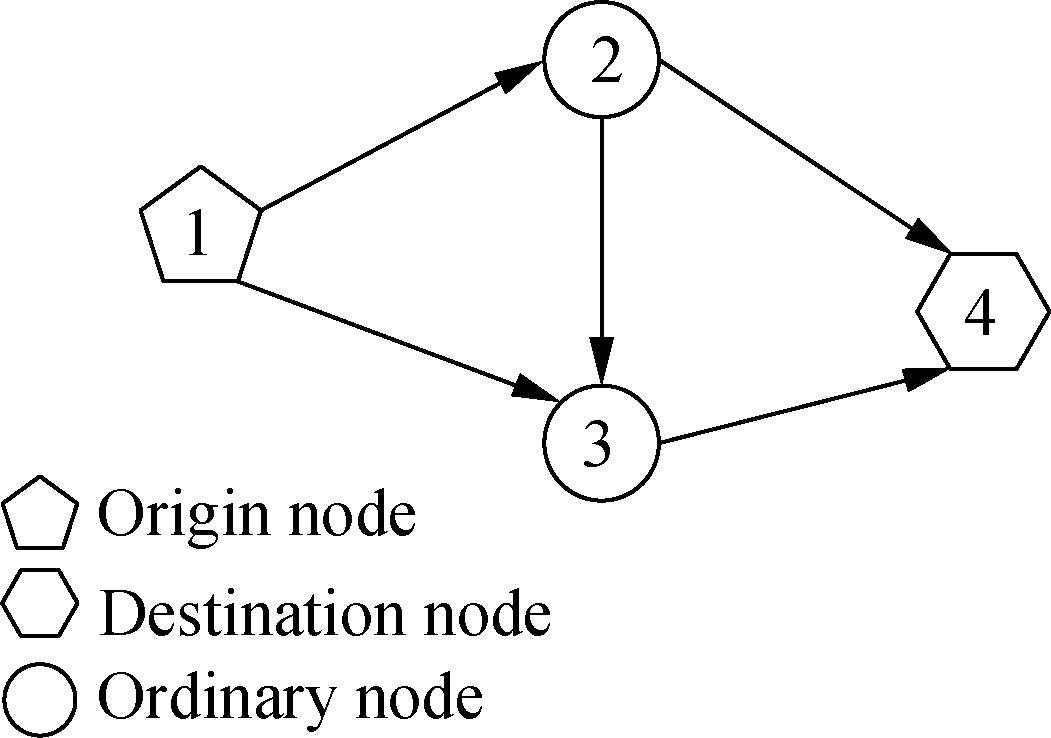
Fig.1 Small network
The path and link flows calculated by the proposed mathematical model(i.e., the GNL-SUE model with a distance limit), the GNL-SUE model without a distance limit, and the MNL-SUE model with a distance limit are also shown in Figs.2(a),(b), and(c), respectively.
Fig.2 shows that the path and link flows assigned by the proposed mathematical model are different from the GNL-SUE model without a distance limit and the MNL-SUE model with a distance limit.This difference is due to the consideration of the distance limit of the BEVs and the similarities between paths by the proposed model.More specifically, Figs.2(a)and(b)reveal the results of path flows assigned by the proposed mathematical model and the GNL-SUE model without a distance limit, wherein GV flow is assigned to paths 1, 2, and 3, while BEV flow is not assigned to paths 1 and 2.GV users are unaffected by the distance limit, while the length of paths 1 and 2 are greater than the distance limit of BEVs.Therefore, no BEV users travel on the two paths.

(a)

(b)

(c)
Fig.2 Comparison of path flows and link flows at equilibrium.(a)Comparison of GV path flows;(b)Comparison of BEV path flows;(c)Comparison of link flows
Additionally,Fig.2(c)shows that the link flows assigned by the proposed mathematical model on links 1 and 5 are smaller than those of the MNL-SUE model with a distance limit.Meanwhile, the link flows assigned by the proposed mathematical model on links 2 and 4 are larger than those of the MNL-SUE model with a distance limit.This finding is due to the MNL-SUE model with a distance limit, which does not consider the similarities between the paths.Therefore, the flows of the overlapping links are overestimated.By contrast, the proposed mathematical model overcomes the IIA drawback of the MNL-SUE model with a distance limit by considering the similarity among various paths.Therefore, the links with multiple overlapping paths are assigned fewer flows than the MNL-SUE model with a distance limit.
3.2 Nguyen-Dupuisnet work: Performance for range anxiety issues
The Nguyen-Dupuis network is selected to analyze the effect of the distance limit parameter on the path flows of GVs and BEVs.This network includes 4 O-D pairs, 13 nodes, 19 links, and 25 paths, as shown in Fig.3.The total demand for each O-D pair is q1-2=660,q1-3=495,q4-2=412.5, and q4-3=495.Other corresponding parameters are the same as those set in the small network.The free-flow travel time and capacity for each link on the Nguyen-Dupuis network are shown in Tab.3.The values in Tab.3 are adopted from Xu et al[36].The path composition and length are exhibited in Tab.4.The values in Tab.4 are adopted from Jiang et al[6].

Fig.3 Nguyen-Dupuis network
Tab.3 Link characteristics
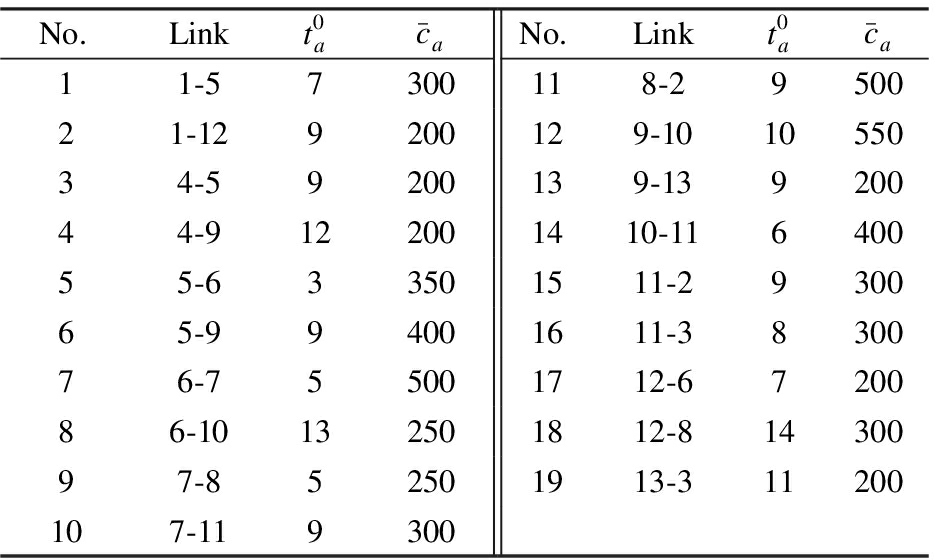
No.Linkt0ac-aNo.Linkt0ac-a11-57300118-2950021-129200129-101055034-59200139-13920044-9122001410-11640055-633501511-2930065-994001611-3830076-755001712-6720086-10132501812-81430097-852501913-311200107-119300
Tab.4 Path composition and path length

O-DPathNode sequencePath length1-211-12-8-23221-5-6-7-8-22931-5-6-7-11-23341-5-6-10-11-23851-5-9-10-11-24161-12-6-7-8-23571-12-6-7-11-23981-12-6-10-11-2441-391-5-9-13-336101-5-6-7-11-332111-5-6-10-11-337121-5-9-10-11-340131-12-6-7-11-338141-12-6-10-11-3434-2154-9-10-11-237164-5-6-7-8-231174-5-6-7-11-235184-5-6-10-11-240194-5-9-10-11-243254-5-9-10-11-3424-3204-9-13-332214-9-10-11-336224-5-9-13-338234-5-6-7-11-334244-5-6-10-11-339
The variation of the path flows of GV and BEV with distance limits is depicted in Fig.4 to examine the impacts of the distance limit on the path flows of GV and BEV in each O-D pair.
Fig.4 shows that only 2 to 4 paths in each OD pair are available and carry BEV flows when D tightens.BEV flows are assigned to additional paths due to the increase in the number of paths available when D loosens, and the BEV flows gradually tend to stabilize.By contrast, the GV flows are assigned to each path in four O-D pairs because no distance limit exists.Moreover, the GV and BEV flows on some paths(e.g., paths 1, 10, 16, and 20)show opposite variations as D increases.This phenomenon may be explained by the strong influence of distance limits on the route choice behavior of BEV users.In other words, BEV users are not allowed to travel on
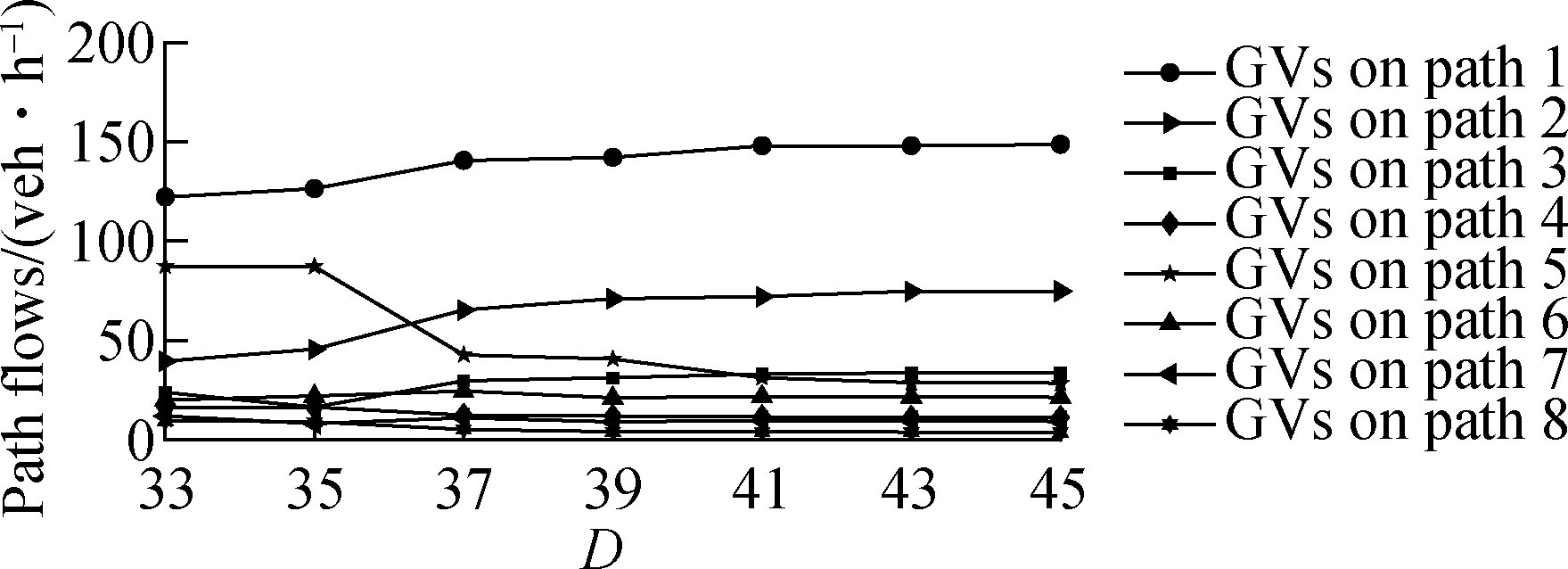
(a)

(b)
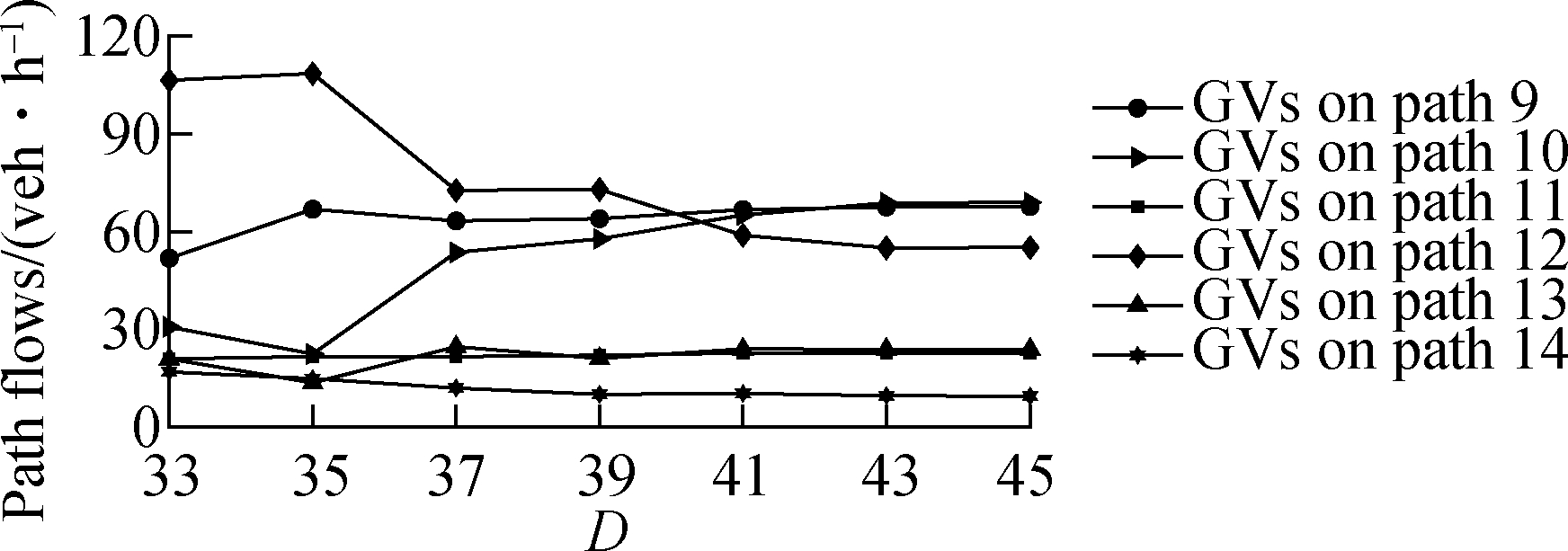
(c)
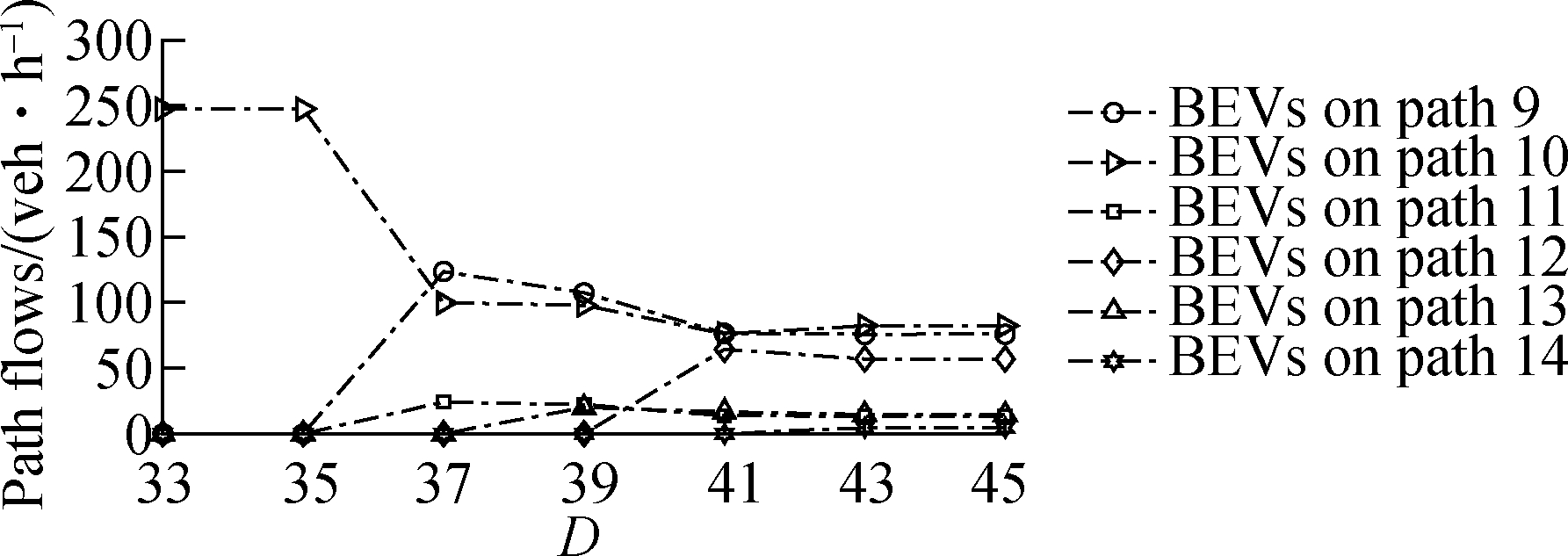
(d)

(e)
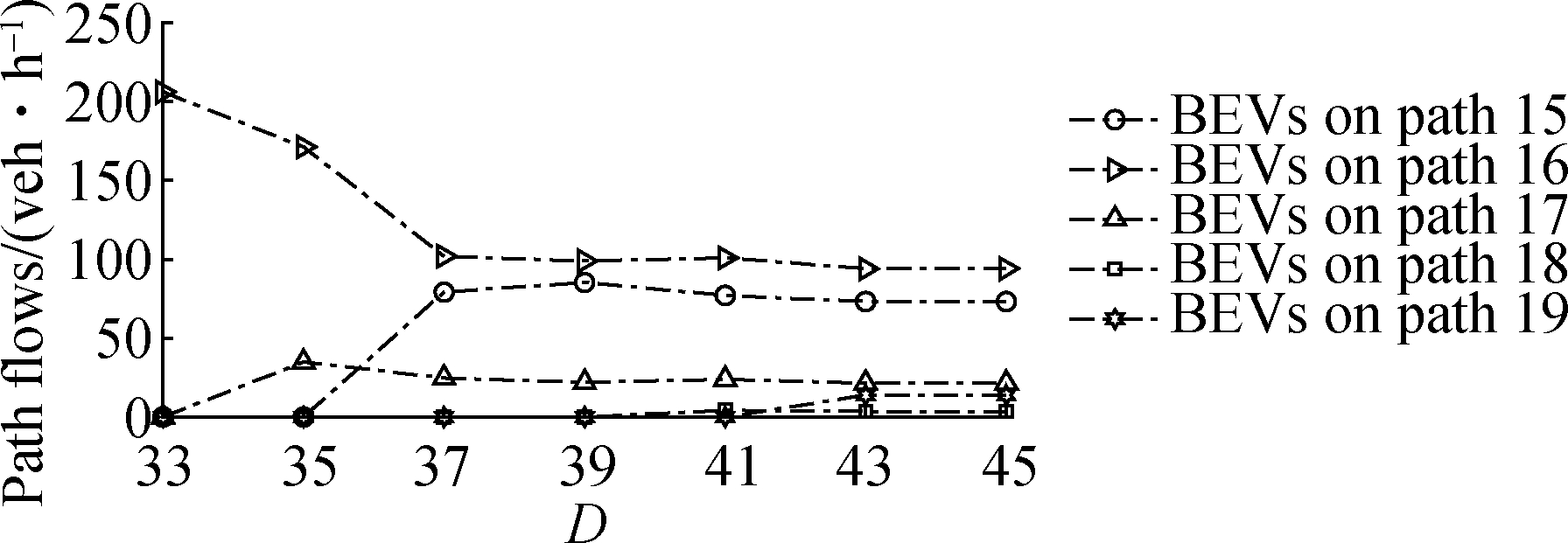
(f)
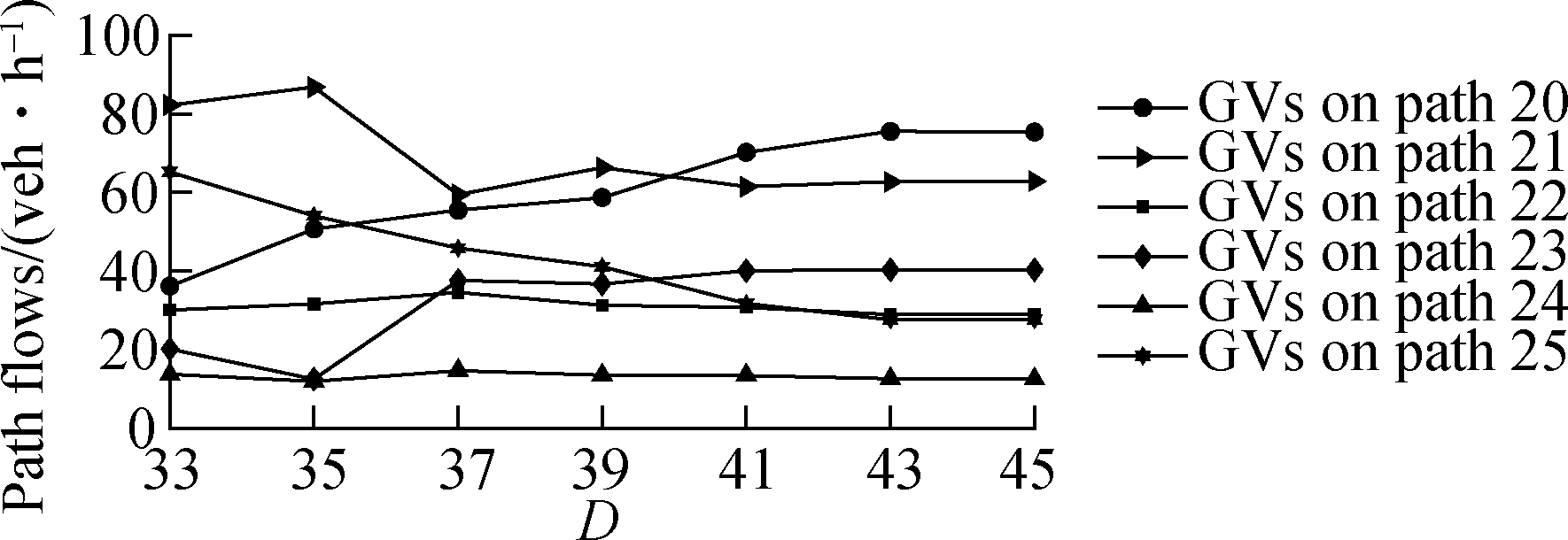
(g)
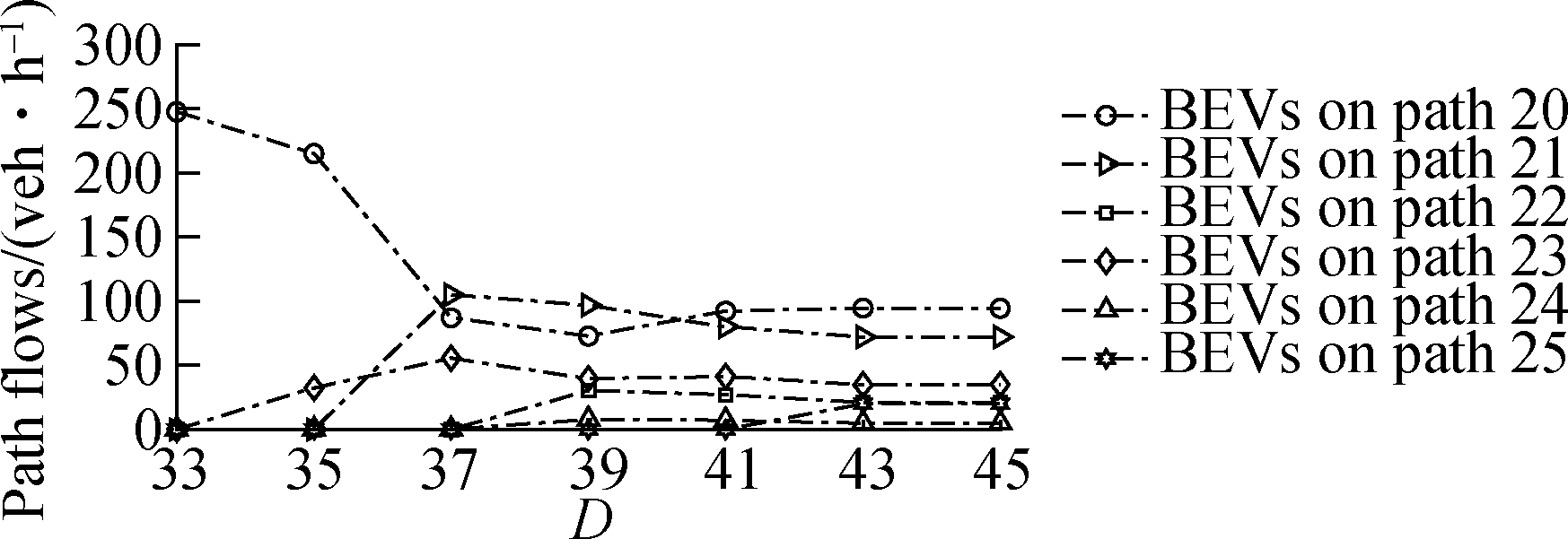
(h)
Fig.4 Variation of path flows of GV and BEV with the distance limit.(a)GV path flows in O-D pair(1, 2);(b)BEV path flows in O-D pair(1, 2);(c)GV path flows in O-D pair(1, 3);(d)BEV path flows in O-D pair(1, 3);(e)GV path flows in O-D pair(4, 2);(f)BEV path flows in O-D pair(4, 2);(g)GV path flows in O-D pair(4, 3);(h)BEV path flows in O-D pair(4,3)
paths restricted by distance; thus, they tend to choose short paths to complete their trips.These short paths will then become oversaturated due to the entry of BEV users, which causes a significant decline in the capacity of the links contained in those paths and a substantial increase in path travel time.Therefore, GV users prefer to use these unsaturated paths to reduce their travel time.
4 Conclusions
1)A modified GNL-SUE model is proposed by incorporating the constraints of multiple user classes with distance limits on BEVs.An equivalent mathematical model and associated solutions were also provided for the proposed model.
2)The distance limit has an impact on the path and link flows at equilibrium, and the proposed mathematical model can overcome the IIA drawback of the MNL-SUE model with distance limits by handling the overlapping path issue.
3)Results using the Nguyen-Dupuis network show that the proposed approach can handle the range anxiety issue by selecting different distance limit parameters in traffic assignment.
[1] Offer G J,Howey D, Contestabile M, et al.Comparative analysis of battery electric, hydrogen fuel cell and hybrid vehicles in a future sustainable road transport system[J].Energy Policy, 2010, 38(1): 24-29.DOI:10.1016/j.enpol.2009.08.040.
[2] Mirchandani P, Adler J, Madsen O B G.New logistical issues in using electric vehicle fleets with battery exchange infrastructure[J].Procedia-Social and Behavioral Sciences, 2014, 108: 3-14.DOI:10.1016/j.sbspro.2013.12.815.
[3] Tu R, Gai Y J, Farooq B, et al.Electric vehicle charging optimization to minimize marginal greenhouse gas emissions from power generation[J].Applied Energy, 2020, 277: 115517.DOI:10.1016/j.apenergy.2020.115517.
[4] Breuer J L, Samsun R C,Stolten D, et al.How to reduce the greenhouse gas emissions and air pollution caused by light and heavy duty vehicles with battery-electric, fuel cell-electric and catenary trucks[J].Environment International, 2021, 152: 106474.DOI:10.1016/j.envint.2021.106474.
[5] Kavianipour M, Fakhrmoosavi F, Singh H, et al.Electric vehicle fast charging infrastructure planning in urban networks considering daily travel and charging behavior[J].Transportation Research Part D: Transport and Environment, 2021, 93: 102769.DOI:10.1016/j.trd.2021.102769.
[6] Jiang N,Xie C.Computing and analyzing mixed equilibrium network flows with gasoline and electric vehicles[J].Computer-Aided Civil and Infrastructure Engineering, 2014, 29(8): 626-641.DOI:10.1111/mice.12082.
[7] Cano Z P, Banham D, Ye S Y, et al.Batteries and fuel cells for emerging electric vehicle markets[J].Nature Energy, 2018, 3(4): 279-289.DOI: 10.1038/s41560-018-0108-1.
[8] Jiang N,Xie C, Waller S T.Path-constrained traffic assignment[J].Transportation Research Record: Journal of the Transportation Research Board, 2012, 2283(1): 25-33.DOI:10.3141/2283-03.
[9] He F, Yin Y F,Lawphongpanich S.Network equilibrium models with battery electric vehicles[J].Transportation Research Part B: Methodological, 2014, 67: 306-319.DOI:10.1016/j.trb.2014.05.010.
[10] Jiang N,Xie C, Duthie J C, et al.A network equilibrium analysis on destination, route and parking choices with mixed gasoline and electric vehicular flows[J].EURO Journal on Transportation and Logistics, 2014, 3(1): 55-92.DOI:10.1007/s13676-013-0021-5.
[11] Xie C, Jiang N.Relay requirement and traffic assignment of electric vehicles[J].Computer-Aided Civil and Infrastructure Engineering, 2016, 31(8): 580-598.DOI:10.1111/mice.12193.
[12] Xu M, Meng Q, Liu K.Network user equilibrium problems for the mixed battery electric vehicles and gasoline vehicles subject to battery swapping stations and road grade constraints[J].Transportation Research Part B: Methodological, 2017, 99: 138-166.DOI:10.1016/j.trb.2017.01.009.
[13] Liu Z C, Song Z Q.Network user equilibrium of battery electric vehicles considering flow-dependent electricity consumption[J].Transportation Research Part C: Emerging Technologies, 2018, 95:516-544.DOI: 10.1016/j.trc.2018.07.009.
[14] Tran C Q, Ngoduy D,Keyvan-Ekbatani M, et al.A user equilibrium-based fast-charging location model considering heterogeneous vehicles in urban networks[J].Transportmetrica A: Transport Science, 2020, 17(4): 439-461.DOI: 10.1080/23249935.2020.1785579.
[15] Jing W T, Kim I,Ramezani M, et al.Stochastic traffic assignment of mixed electric vehicle and gasoline vehicle flow with path distance constraints[J].Transportation Research Procedia, 2017, 21: 65-78.DOI:10.1016/j.trpro.2017.03.078.
[16] Riemann R, Wang D Z W, Busch F.Optimal location of wireless charging facilities for electric vehicles: Flow-capturing location model with stochastic user equilibrium[J].Transportation Research Part C: Emerging Technologies, 2015, 58: 1-12.DOI:10.1016/j.trc.2015.06.022.
[17] Yang Y, Yao E J, Wang M Y, et al.Stochastic user equilibrium assignment model for electric vehicle under hybrid traffic condition[J].China Journal of Highway and Transport, 2015, 28(9): 91-97.(in Chinese)
[18] Huan N, Yao E J, Yang Y, et al.Stochastic dynamic user equilibrium assignment model considering penetration of electric vehicles[J].Journal of Traffic and Transportation Engineering, 2019, 19(5): 150-161.DOI:10.19818/j.cnki.1671-1637.2019.05.015.(in Chinese)
[19] Gao H, Liu K, Peng X C, et al.Optimal location of fast charging stations for mixed traffic of electric vehicles and gasoline vehicles subject to elastic demands[J].Energies, 2020, 13(8): 1964.DOI: 10.3390/en13081964.
[20] Wen C H, Koppelman F S.The generalized nested logit model[J].Transportation Research Part B: Methodological, 2001, 35(7): 627-641.DOI:10.1016/S0191-2615(00)00045-X.
[21] Daganzo C F, Sheffi Y.On stochastic models of traffic assignment[J].Transportation Science, 1977, 11(3): 253-274.DOI:10.1287/trsc.11.3.253.
[22] Xu X D, Chen A, Zhou Z, et al.Path-based algorithms to solve C-logit stochastic user equilibrium assignment problem[J].Transportation Research Record, 2012, 2279(1): 21-30.DOI:10.3141/2279-03.
[23] Zhou Z, Chen A,Bekhor S.C-logit stochastic user equilibrium model: Formulations and solution algorithm[J].Transportmetrica, 2012, 8(1): 17-41.DOI:10.1080/18128600903489629.
[24] Wang G C, Chen A,Kitthamkesorn S, et al.A multi-modal network equilibrium model with captive mode choice and path size logit route choice[J].Transportation Research Part A: Policy and Practice, 2020, 136: 293-317.DOI:10.1016/j.tra.2020.03.035.
[25] Tang J J, Wang Y W, Hao W, et al.A mixed path size logit-based taxi customer-search model considering spatio-temporal factors in route choice[J].IEEE Transactions on Intelligent Transportation Systems, 2019, 21(4): 1347-1358.DOI:10.1109/TITS.2019.2905579.
[26] Wang J,Peeta S, He X Z, et al.Combined multinomial logit modal split and paired combinatorial logit traffic assignment model[J].Transportmetrica A—Transport Science, 2018, 14(9): 737-760.DOI:10.1080/23249935.2018.1431701.
[27] Koppelman F S, Wen C H.The paired combinatorial logit model: Properties, estimation and application[J].Transportation Research Part B: Methodological, 2000, 34(2): 75-89.DOI:10.1016/S0191-2615(99)00012-0
[28] Vovsha P.Application of cross-nested logit model to mode choice in tel aviv, Israel, metropolitan area[J].Transportation Research Record: Journal of the Transportation Research Board, 1997, 1607(1): 6-15.DOI:10.3141/1607-02.
[29] Bekhor S, Reznikova L, Toledo T.Application of cross-nested logit route choice model in stochastic user equilibrium traffic assignment[J].Transportation Research Record: Journal of the Transportation Research Board, 2007, 2003(1): 41-49.DOI:10.3141/2003-06.
[30] Bekhor S, Toledo T, Reznikova L.A path-based algorithm for the cross-nested logit stochastic user equilibrium traffic assignment[J].Computer-Aided Civil and Infrastructure Engineering, 2009, 24(1): 15-25.DOI:10.1111/j.1467-8667.2008.00563.x.
[31] Bekhor S, Prashker J N.Stochastic user equilibrium formulation for generalized nested logit model[J].Transportation Research Record: Journal of the Transportation Research Board, 2001, 1752(1): 84-90.DOI:10.3141/1752-12.
[32] Li X F, Lang M X.Multi-class and multi-criteria stochastic user equilibrium model based on generalized nested logit model[J].Journal of Transportation Systems Engineering and Information Technology, 2014, 14(4): 139-145.DOI:10.16097/j.cnki.1009-6744.2014.04.024.(in Chinese)
[33] Koppelman F S, Sethi V.Incorporating variance and covariance heterogeneity in the generalized nested logit model: An application to modeling long distance travel choice behavior[J].Transportation Research Part B: Methodological, 2005, 39(9): 825-853.DOI:10.1016/j.trb.2004.10.003.
[34] Prashker J N, Bekhor S.Investigation of stochastic network loading procedures[J].Transportation Research Record: Journal of the Transportation Research Board, 1998, 1645(1): 94-102.DOI:10.3141/1645-12.
[35] Fisk C.Some developments in equilibrium traffic assignment[J].Transportation Research Part B: Methodological, 1980, 14(3): 243-255.DOI:10.1016/0191-2615(80)90004-1.
[36] Xu H L, Lou Y Y, Yin Y F, et al.A prospect-based user equilibrium model with endogenous reference points and its application in congestion pricing[J].Transportation Research Part B: Methodological, 2011, 45(2): 311-328.DOI:10.1016/j.trb.2010.09.003.